A few weeks ago Sam Mustafa announced his latest rule set he would be publishing, “Maurice”, which would cover the rump of the 18th Century and include Campaign and Imagi-Nations aspects… This was especially interesting to me as I have really enjoyed Lasalle since its release (it’s the first time I’ve been totally excited and passionate about Napoleonics in 35 or so years of wargaming) and if Maurice was going to be anything along a similar vein I expected something worth getting excited about. Furthermore I’ve really wanted to get into 18th Century in some form, and the WSS (War of the Spanish Succession) has always interested me (because of my childhood memories of reading about John Churchill, Duke of Marlborough, and Prince Eugène of Savoy, defeating the dastardly French at Blenheim & Ramillies, etc). What’s more for me the WSS has always held that ‘Old School’ feel about it that brings back memories of pouring over Charles Grant’s “The Wargame” as a teenager and dreaming of one day having those large 18th Century Armies like in the book…
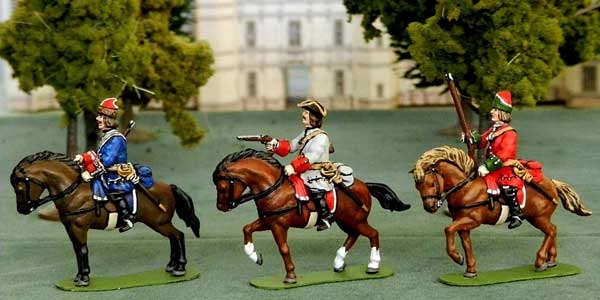
Anyway, Sam has now released Maurice Lite this week, a free basic version of Maurice, so any and all can get a feel for the basic system and try out some games with the basic system. I was able, co-incidentally, to play my first game a few days ago as well, and so have been able to digest the rules and get a sense of how they play. So here’s my first take on things…
Concepts

In Maurice Sam Mustafa has endeavoured to bring some different concepts together to interact – while these aren’t necessarily original individually the way they are combined is to some degree I believe. Some of the key ingredients (including some of these concepts) are:
Cards – everything you do in the game is driven by cards, if you want to activate units to move or charge, or artillery to bombard (i.e. fire beyond canister range) you must play cards to do so. Cards have multiple uses, each card having a command span and some other function – if you activate units you need to play enough cards to total the command span from your C-in-C to your closest unit (of the group you are activating – of which more below). However this means using up cards that might have other benefits (such as making your units shoot better, or defend in combat better, or so on). This means every turn you must weigh up the pros & cons of taking one action over another, it also means the further your troops are from the C-in-C the more costly in cards having them do anything will be. And if you have no cards in your hand you can’t do anything! Furthermore you only get to do ‘one’ action or event with your cards in your round (turn) and then it’s your opponents round – unless of course you have a “Coordinated” card for example (which allows two move or rally actions).
Once you activate units you may also be able to play a card to enhance their actions, for example if you charge you might then be able to play an enhancement card to improve your units combat scores for the subsequent combat, but beware as your opponent may trump (or rather interrupt) your action (see below).
Forces – in Maurice there is no fixed command structure – you have your C-in-C (who rarely if ever moves), and you have all your units. Forces are formed ‘on the fly’ each time you choose to do anything; a force is all units of the same type, in the same formation, within a certain distance of each other (2BW – Base Widths). So there is not going to be combined arms, mixed formations, or such, that you might see occur in other rule sets, as these will make your army near un-manoeuvrable – and you need to focus on maintaining supporting groups of like units. This all feels right to me for 18th century warfare; the rules reward you for maintaining analogous groups of units in identical formations in close support of each other. The full version of Maurice will introduce optional notables of varying quality (typically minor nobles or princes or such who aspire to be generals and think a lot of themselves) that you then need to assign command of some of your army to – what do you do with that incompetent prince of the realm who’s society station says he must command your best cavalry?!
Army Size & Units – typically your army is going to be about 11-16 units of infantry, cavalry, or artillery. Infantry and cavalry are essentially the same as in Lasalle if you are familiar with that (i.e. 4 bases each), while artillery is individual bases. As was done historically if you have more than 1 artillery base you can form them into ‘ad hoc’ batteries (in fact you definitely want to do this due to how forces work as noted above) – such batteries might have all stands in contact – or be in a more dispersed formation (i.e. gun line) but being careful to comply with the force proximity rules (see above). Dispersing artillery all through your army will be ineffective and costly – it needs to be concentrated at a key point. Because the scale is abstract these units can be almost anything – infantry & cavalry might be companies & squadrons, and gun bases 1-2 real guns, or they might each represent 4-12 battalions/regiments or 8-16 guns or so respectively (e.g. if a scaled down battle of Blenheim or Ramillies).
However for my armies’ and this review’s purposes I’m assuming they are going to be (nominally) single infantry battalions and cavalry regiments, and about 2-6 real guns per artillery base (and will talk assuming these general terms from here on – in fact this is the logic I will use in building my new WSS armies).
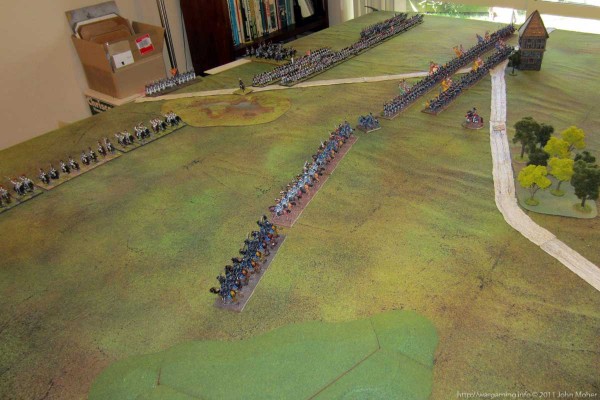
Volley Fire – is something that may happen every turn – it’s the only thing you can do always, but watch out because if you do your opponent gets to reply… And it can be very bloody! There are also interrupt cards (see below) that might cause it to back-fire, allowing your opponent to discharge first in the volley fire phase or out shoot you! Volley fire includes canister (short range) artillery fire.
Interruptions – the cards allow the opposing player to potentially interject on any action the active player takes, if the active player volley fires the opponent might be able to interrupt with a card giving him first discharge, or with one reducing the opponents firing effectiveness (remembering the active player himself might have played a similar card already to modify his or his opponents firing before the opponent interrupted). As a result if your opponent has cards you can never 100% guarantee your planned action or that firing will go exactly as you intend.
Events – are cards which instead of activating a force (see above) allow you to choose to have a specific event happen – these can be of various types and obviously the full version will have a more comprehensive selection than the ‘Lite’ edition. Events may include ‘life saving’ type actions for a single unit, guaranteed activations (for troops far from the C-in-C’s command span), a disadvantage for or effect on your opponent, etc. What’s more players can potentially develop their own custom events to include in the deck for specific historical refights or key imagi-nation or scenario factors (e.g. “complete 1 stage of your pontoon bridge construction” or such like)…
Army Morale – is relatively simple in Maurice Lite, if you loose half your units (rounded up, of any type) you break. Obviously in the full version of Maurice army morale is handled in more detail and is affected by the type of unit lost, the loss or gaining of objectives, etc.
An Introductory Game
In our first game we didn’t have any appropriate troops (at least in 28mm) so we have used Napoleonic armies – you’ll have to excuse the uniforms and headgear in the photos. Cam setup first, putting a force of 3 cavalry off to one flank with 2 more close enough to join them fairly rapidly, forcing me to counter him – however I banked on 3 of my cavalry holding him off before his other 2 cavalry could aid them, and so put my remaining single cavalry unit on the extreme opposite flank opposing his infantry (where he had no cavalry) – in fact this proved annoying more to me than Cam as due to how forces work I simply never could spare the resources to activate that unit so far away from my C-in-C. The remainder of the set-up was conventional with our infantry facing off against each other in line, both sides deployed in 2 ranks, with my sole artillery unit in the centre covering the infantry’s left flank… And we both placed our C-in-C’s near but not exactly in the centre (to try and reduce the command distance to the further units, especially my cavalry mentioned above).
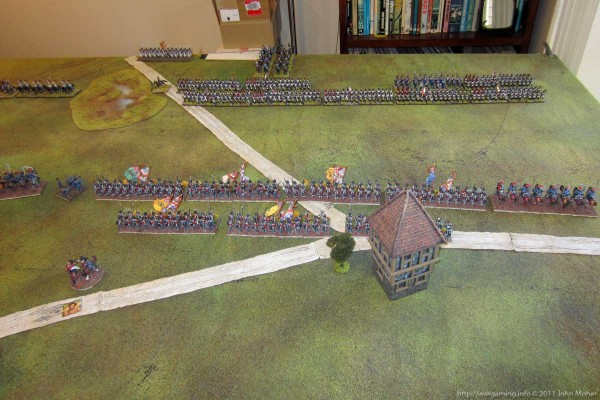
The game started with Cam’s French infantry advancing aggressively on my British infantry on my right, infantry move fairly rapidly in the game (4BW in line) and also shoot 4BW, so it only takes a couple of ‘rounds’ to get into volley fire range of each other, and by the use of a “Coordinated” card Cam was also able to move a second force in the same round, his reserve cavalry starting their way to join the cavalry on the French right – however I then played an “Unexpected Delay” interrupt on him adding 8BW to his command radius and forcing him to burn up 2 more cards to complete the action (so it ended up costing him 4 cards from his hand to move his reserve cavalry force). On the subject of movement cavalry move 8BW normally, so there is the common 4 to 8 move ratio (or rather 1 to 2) familiar I suspect to many Old School gamers – however in Maurice cavalry are further restricted to a 4BW move when they are ‘near the enemy’ (i.e. within the 4BW Musketry & Canister range), this ensuring they cannot contact infantry in charge combat without at least being at risk of suffering one round of volley fire.
On my first round I initially passed to draw extra cards into my hand as I wanted to try and save some good cards I had got initially for key actions I planned in a few rounds time (basically the less aggressive action you take each ‘round’ the more card replenishments you get – passing gets you 3 new cards, rallying or artillery bombardment 2, marching 1, and charging or an event 0 – so there is an incentive to occasionally be passive and build up your hand of cards ready for 2-3 rounds of aggressive actions).
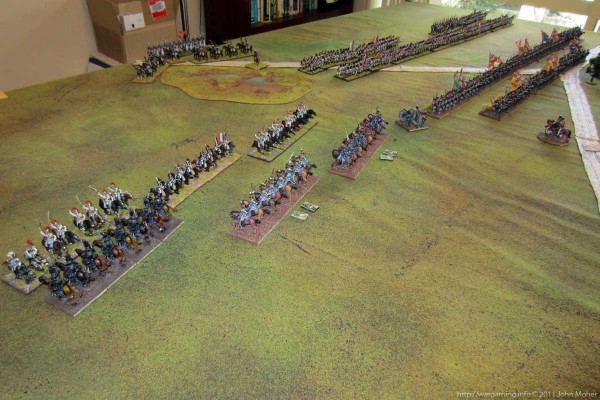
Cam now advanced his cavalry on his right, and then charged two of my units – in what was an ineffectual drawn combat first up. I then countered Cam by charging my cavalry back at his, in the next round. Cam had modifying cards (“Stirrups In”) to give his cavalry a combat bonus both times – however the end result after both rounds of combat was a somewhat bloody but drawn affair (both sides ended up with 2 to 3 DISR – Disruptions – on each unit after the 2 separate combats; note that a unit can’t charge when it has had 4 DISR and is destroyed when it gets to 5). The result for now being my cavalry and the French were stalemated, at least until someone did some rallying as no one wanted to risk combat when only 2 DISR from destruction (see the third game photo). Next Cam’s infantry moved into musketry range of my line of redcoats, and I immediately called for a volley fire phase – I played “Deadly fire” to modify my shooting (a to hit bonus) but Cam then smacked me with a “First Fire” interrupt and got to shoot first despite being the ‘passive’ player (as it was my round I was the active player and should have shot first).
Firing is resolved by throwing a dice for each stand eligible to fire at a target unit (artillery get 2 dice in canister range) and the to-hit number is adjusted if a (firing) unit is reasonably disrupted (i.e. 2+ DISRs) or otherwise disadvantaged (e.g. target in cover) – in ideal conditions you have a 50% chance of hitting, better if modified by a card. All hits are then rerolled to convert into DISRs (versus the Lasalle mechanic where you arbitrarily get a DISR for 2 hits, 2 DISR for 5 hits, etc). This means the DISR effects are a bit more variable than in Lasalle, and it’s less about steadily grinding the enemy down with attrition and is more fluid with greater chances of dramatic results either way.
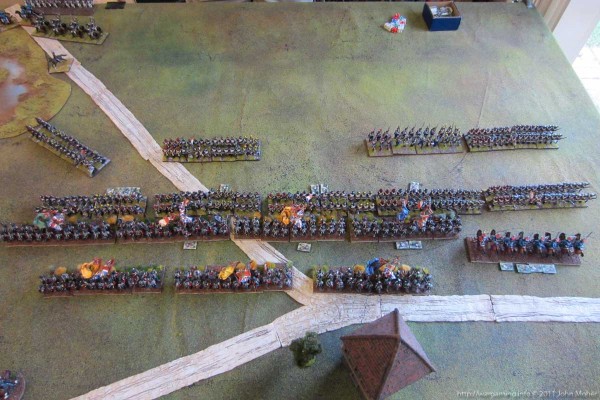
Needless to say Cam’s firing reduced the effectiveness of my return fire a little due to the damage he inflicted first – however both our firing was pretty bloody (mine aided by the 2 extra dice I gained from my artillery’s canister fire at the end of my line) and we inflicted 8 DISRs in total each on the other side’s opposing units (see the fourth photo). This was just a little scary to be honest – as both of us ended up with a unit on 4 DISR immediately (i.e. 1 hit from destruction) and others with 2 or 3… I then charged – with my infantry – into Cam’s line of Frenchmen and we rolled our combat scores for each unit modified appropriately (see page 19 of the Maurice Lite PDF). Cam’s first unit (with 4 DISR) was basically wiped away instantly, it’s base factor was 6 -4 for 4 DISRs and -1 for outnumbered (2 of my units faced it) = 1 plus a die roll (Cam scored 2 so at 3 total it was well below my two opposing units and his unit was destroyed regardless of the difference as only 1 DISR was needed to ‘finish it off’). All units in charge combat suffer at least 1 DISR – so it always incurs a cost to the active player even if he/she wins all the actual combats – and it does mean a defending unit starting on 4 DISR will always be destroyed (as was Cam’s case above), and will be destroyed even if it wins the combat (an unusual quirk that some players may find hard to get used to).
Continuing the combat results Cam had also got a bad roll for his second unit and it was also destroyed (despite only having had 1 DISR initially). Our remaining units on both sides all got fairly similar scores, and the result was the rest of the British got thrown back with generally 1 DISR inflicted to each unit on either side (see the fifth photo). This seemed quite bloody – but considering the abstract nature of time in the game, and the fact the charge combat is considered to include point-blank musketry and such – it may be appropriate as modelling a prolonged ‘real-time’ assault (e.g. anything from 15-60 minutes) in a single round or pair of rounds in game time. I personally have no issue with this abstract non-linear concept of time in wargames, but others may dislike it.
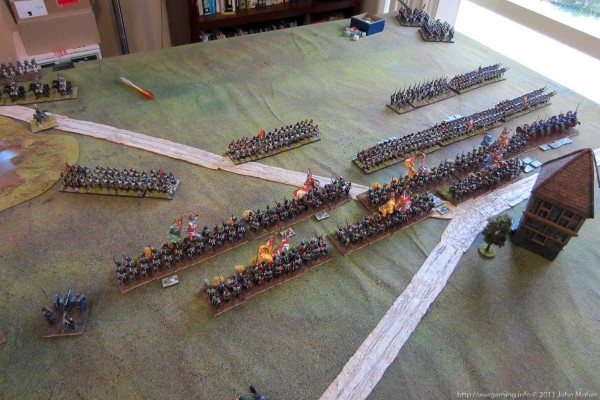
Effectively almost all focus went on the infantry at this point by both of us – I burnt up all my cards rapidly in my next two rounds following up the volley fire phase with charges – keeping Cam’s infantry on the back foot. Cam tried to rally and reorganise his. My initial success above was particularly decisive as it effectively broke his line in two, and as a result prevented him from activating all his infantry in the same round (as they were now 2 distinct ‘forces’, while mine still maintained their line and integrity as a single force). When my second charge smashed the ‘second line’ unit in the centre as well (see sixth and seventh photos) it was a pretty decisive event – Cam’s infantry on his flank were now isolated from his C-in-C and needed a loft of ‘span’ points to be activated to take any action.
However it wasn’t all one way and Cam started to slowly eliminate my units with his volley fire (Cam was so perturbed by the initial outcomes of volley firing he refused to initiate a volley fire phase in his rounds after the first occasion, instead relying solely on his reply-fire in my volley phases). We were both being very aggressive and pouring modifier and interrupt cards into firing and combat, and at this stage were rarely attempting to rally or take other actions. As a result after about 4 rounds each focusing on the infantry Cam had lost 3 infantry units and I had also lost 3, plus my right flank cavalry unit as well (that got decimated by unanswered volley fire)! I had actually even spent a “Valeur et Discipline” event card on this latter unit earlier to automatically clear the first 4 DISRs off it – but the next two volley fire phases immediately plastered it with 5 DISRs again and it was gone!
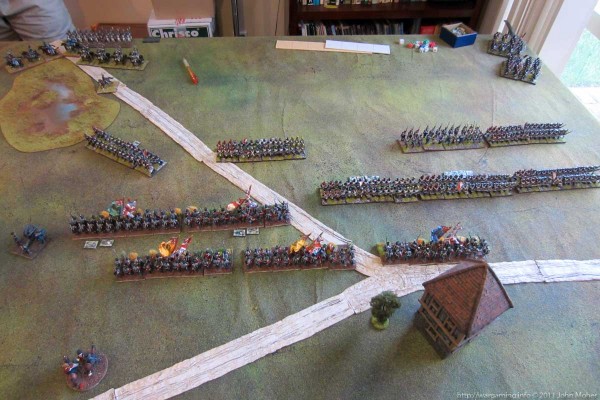
However despite losing more units I was in the stronger position – I had cut Cam’s infantry in half and effectively isolated his 5 right flank units from the 1 surviving one in the centre (and would destroy another one of these infantry units in a couple more rounds). However by this stage I had completely exhausted my cards by repeated charges and such, and was forced to pass a round to draw some fresh cards into my hand, followed by attempting to rally my cavalry who had been sitting around doing nothing for several rounds (Cam had already managed to partially rally his cavalry, as he couldn’t effectively activate his infantry on the other flank with his current cards). While I set out to slowly eliminate Cam’s remaining infantry our cavalry finally both initiated new charges against each other. One of my units was destroyed, but otherwise the results were again indecisive elsewhere – with most units being left (again) with 2, 3, or 4 DISRs and needing to rally again (to try an remove them).
It’s worth noting at this stage that Cam’s 2 reserve cavalry units had meanwhile ended up stuck in no-mans-land – they didn’t move again after the first round as there simply wasn’t the resources Cam could spare to reactivate them – my aggressive pressure on his infantry, and the indecisive cavalry combat on the flank, drew all his actions and left this remaining cavalry stranded. The sole attempt to activate them later in the game I managed to interrupt with another “Unexpected Delay” – this time Cam didn’t have the extra cards to compensate so his initial activation cards were lost and the cavalry didn’t move!
In Maurice you will need to ensure your reserves are well placed to support a specific part of the line rather than trying to manoeuvre half-way across the table. Cam’s 2 reserve cavalry would have been better deployed in line, more to his left, and thereby could have provided a viable cavalry ‘force’ to easily counter attack my main infantry breakthrough with minimal cards needed for activation…
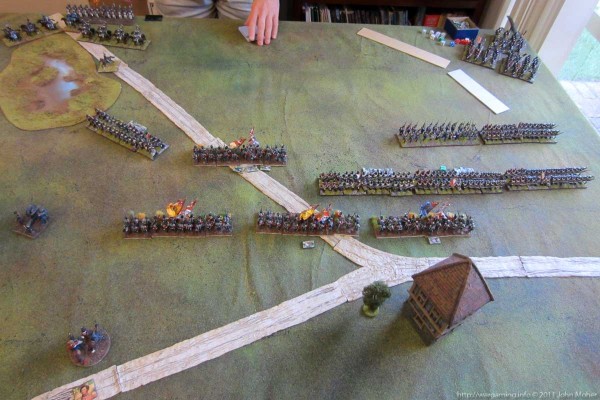
After this we had a few rounds of more activity – Cam’s victorious cavalry unit (see the eighth photo) pressed into the rear of my position alone, overrunning my C-in-C’s position and forcing him to move his headquarters (moving your C-in-C costs ‘a card’ for activation so normally will only be done if absolutely necessary by most players – however as I had no cards left in my hand – again – to discard at this time I had to lose a morale point instead). However that was about the last offensive action Cam’s French force could manage – my infantry continued to volley fire & charge Cam’s isolated infantry on the flank, whittling them away with no easy way for him to respond, and as both armies were now effectively reduced to their last morale point(s) and Cam felt the French had no viable way to inflict more casualties before more of their infantry were destroyed he conceded and we called the game a narrow British victory…
The whole game had taken under 2 hours to play – and we probably cycled through about 20 or so ‘rounds’ (turns) each – so as can be seen it was fast, furious, tense, but also fun. Obviously we were both being fairly aggressive, and tended not to plan too well for building a strong hand of cards to conduct a coordinated attack; and only resorted to the rally action if absolutely necessary or low on cards (in fact as mentioned I depleted my entire hand twice and was forced to pass to draw 3 fresh cards to restart my hand each time).
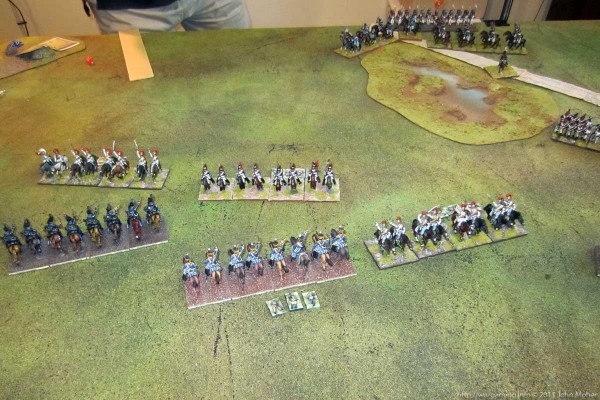
Impressions
Overall the game played well, and was fast and exciting. Cam and I had both agreed it was fairly tense, although Cam was a bit shocked by how easily infantry could be destroyed when given a ‘one-two’ punch by the enemy of volley fire (with bonuses) then a charge (with bonuses). Combat bonuses from cards, while not decisive, are effective – if your volley firing is hitting more than 50% of the time it becomes pretty destructive when combined with a following charge combat. This of course makes rallying significant and next game we probably won’t be so super-aggressive, nor so glib about rally actions.
Straight up cavalry vs. cavalry combat looks to be rather indecisive, primarily due to the lack of volley fire which means its quite hard to do that decisive amount of consecutive damage to reach 5 DISR (or to double the defender outright in the charge combat) – which is probably as it should be, at least for the WSS anyway… Bring in supporting fire and/or numerical advantages and that changes but not in a hugely dramatic way. It sounds right to me that cavalry fights should be a bit of a grind-a-thon and take some time to reach a decision. We didn’t get around to having any cavalry vs. infantry fights in this game so can’t easily report on that, and as a result I’m not sure how decisive volley firing against an incoming cavalry unit will be, but I suspect cavalry won’t be hugely successful charging infantry head on (again this sounds vaguely right for my understanding of at least the early 18th Century)…
I’m not sure if there is a lot of incentive to take artillery – which may or may not be historical. Maurice specifically ignores the small 3pdr & 4pdr battalion guns of the era (although you could argue they are represented indirectly by the infantry volley fire range and effectiveness), so artillery units per se only represent the larger 6pdr to 24pdr heavy guns in the army that would be grouped into ad hoc batteries at key points – in the WSS at least these can be relatively scarce so having only 1-2 or even 0 may not be unhistorical. However if you do have 3-4 in your army it may take some figuring out to use them effectively (although the bombard action is a good way to accumulate fresh cards into your hand, while hopefully playing less than you acquired to activate it and inflicting some damage on the enemy in the process).
Sam has made an effort to try and create the ebb and flow feel of battles, both in the way battle lines manoeuvre, but also in the rise and fall of command energy – lack of cards creating natural lulls for one side or the other as they replenish their hands… As a result there is an incentive for players to not always be super-aggressive or such, regardless of the ‘current opportunity’, due to the disadvantage of ‘clearing your hand’ of all cards…. There may develop a lot of subtlety involved in how and when cards are used or held/accumulated, but it will likely take several games to start to get a feel for this as a player and to see how successful Sam has been in this area.
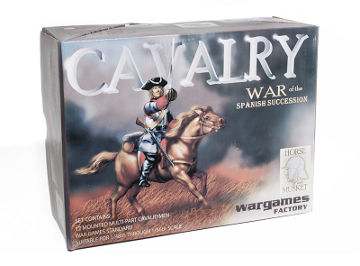 As I have already commented elsewhere I do not doubt it is one of those games that will go through at least 3 phases of ‘appreciation’ for each player – initially it may seem a bit abrupt, abstract, and/or bloody or such as players get their heads around the mechanics and learn to not just charge forward and attack at all costs (as Cam and I did above); then as their knowledge of the basic mechanics improves there may be a perceived OTA (One True Army) by more competitive players and/or the fact it may be perceived a competitive advantage exists in some particular area for one troop type or other (e.g. an all infantry army or such) – but which will then lead to trying alternate tactics and discovering the true extent of what Maurice might offer; however I suspect that players who persevere will eventually (and this will be the true test of Maurice’s success) find the full potential of the system and the ability to truly enjoy the subtleties which will go beyond that OTA stage – and this may prove to be a bit of Nirvana for the Imagi-Nation fans at least.
As I have already commented elsewhere I do not doubt it is one of those games that will go through at least 3 phases of ‘appreciation’ for each player – initially it may seem a bit abrupt, abstract, and/or bloody or such as players get their heads around the mechanics and learn to not just charge forward and attack at all costs (as Cam and I did above); then as their knowledge of the basic mechanics improves there may be a perceived OTA (One True Army) by more competitive players and/or the fact it may be perceived a competitive advantage exists in some particular area for one troop type or other (e.g. an all infantry army or such) – but which will then lead to trying alternate tactics and discovering the true extent of what Maurice might offer; however I suspect that players who persevere will eventually (and this will be the true test of Maurice’s success) find the full potential of the system and the ability to truly enjoy the subtleties which will go beyond that OTA stage – and this may prove to be a bit of Nirvana for the Imagi-Nation fans at least.
But don’t expect at any stage all aspects will match the conventional wargamer’s view of the world, and aspects of the game will not be to some people’s liking (if you want to move and shoot everything every turn you’ll be disappointed). It’s also clearly not a 100% historical rule set, so the purists may quibble – but for me it’s got enough of the historical aspects to feel right without being complex or tedious – and yet seems fun and quick and fairly intuitive, which is all good in my books. While one or two events in the game were unusual or surprising to us – and there is that somewhat “empty battlefield” feeling towards the end of the game too – overall it played well and I think has lots of potential (especially if you can get your head around the somewhat abstract space & time aspects of the scale). I’m well known for liking games that take away a wargamer’s all-knowing god like powers and/or that introduce uncertainty into the sequence or actions available to the gamer, without being completely random, and I think Maurice has lots of promise for this – and look forward to exploring it further – in fact Cam and I have another game planned very very soon…
P.S. I’ve also already started musing over whether, if it fulfils it’s promise, it might eventually be backwards compatible 50 years or so, with just a little modification, to do ECW (or similar later renaissance era conflicts), where the rise of the musket & decline of the pike first began…
Acknowledgement: Title image used with thanks from Steve Cady’s Castles of Tin blog post “Wargames Factory WSS Cavalry – Part 2“.
Post Script
I’ve since been asked if it was fun? The answer is yes – definitely – although also interspersed with tension, and the odd surprise (as alluded to above). On one occasion I think I scored a mass of volley fire hits on Cam’s French infantry (like about 10-12 spread over 4 targets), only to fail to convert almost all to DISRs despite a 50% chance to do so – I’m sure that amused Cam while also being a contrasting relief to the initial couple of volley fires that decimated his troops! I enjoyed the card play aspect – although it can seem a bit distracting at first and led to some procrastination over decisions later in the game on my part! It seems (on first look) to certainly have the right mix of fun & game aspects versus historical feel, and simulation (the latter would clearly be the least significant of the 4), and I can certainly imagine having some great abstract-campaign, linked scenario, or table-top-teaser type games with the system. It seems perfect for those pontoon bridge building actions and such like of C. S. Grant’s! I’m looking forward to having our second bash at it this weekend (its just a pity my new WSS armies are still several months or more away as they are only just beginning construction)…
You can read on with our Second Game & More Thoughts and there’s also further discussion in the TMP thread “Maurice – First Game Impressions“.

Hi John
Thanks for that great AAR. Maurice looks to be very interesting (I like these types of chaos/narrative rules ala Piquet), the ‘historical’ aspect may be addressed somewhat in the full rules (I expect cards/rules/options specific to say Fredericks Prussians) ?
Cheers
Gary
Hi Gary – yes, although I must confess I never overly enjoyed Piquet because it always seemed just a bit [i]too[/i] random for me (i.e. almost random for the sake of being random).
I can say (from the sneak peak I’ve had) there are indeed a sort of ‘generic’ National Characteristic system in the full version that covers all sorts of factors & effects – so you mix and match the ones you believe are appropriate for each historic army (or your imagi-nation nation) and choose them just like units of troops for your Maurice army. Add to this obviously there are different grades of troop quality in the full version, the optional Notables I mentioned above, etc, and you start to get a lot more flavour & variety to recreate key historical aspects of specific armies.
It still probably won’t be 100% historical as a ‘minute by minute’ simulation (especially not for the rivet counters at least who want to see the micro-detail) but like Lasalle it’ll be fun to play, it’ll create the right sort of period activity by the troops in the game, and the end result will generally be a pretty historical result (in both Lasalle & Maurice you need to get your head around the artificial ’empty battlefield’ feeling near the end of many games caused by broken/routing/retreating units being just arbitrarily removed off table – not seeing them ‘[i]stream to the rear[/i]’ makes the games seem bloodier than they are).
Hi John
Ta for further info. Freddie needs his Seydlitz just as Marlbourgh needs his Eugene so nice to the sub-commanders/notablers catered for. I havent played Piquet in ages as mates like yourself found it too extreme 🙂
Field Of Battle though is very good retaining the Card Play and opposed rolls but with equal initiative alternating between players.
(in both Lasalle & Maurice you need to get your head around the artificial ’empty battlefield’ feeling near the end of many games caused by broken/routing/retreating units being just arbitrarily removed off table – not seeing them ‘stream to the rear’ makes the games seem bloodier than they are due to the empty table).
Funnily enough Bob Jones (Piquet author) latest rule set Die Fighting only has routing units with no ‘deaths’ as such so all defeated units stream off the table (unless rallied) but oddly this is tad hard to get head round in similar fashion as no ‘heroic last stands/massacres’ occur.
Really looking forward to ‘full’ Maurice but hope to get a game of lite version
Cheers
Gary
Funnily enough Bob Jones (Piquet author) latest rule set Die Fighting only has routing units with no ‘deaths’ as such so all defeated units stream off the table (unless rallied) but oddly this is tad hard to get head round in similar fashion as no ‘heroic last stands/massacres’ occur.
Sounds like that old original Warhammer stuff from the late 80’s when the only combat result you could ever get was pushing the enemy unit back (until eventually you pushed them off the edge of the table) – no casualties, no army morale failure!
Regarding opposed rolls I’m not always a fan of them – often they are used simply as a lazy mechanic by designers IMO to claim ‘player involvement’ or such when they are really a redundant mechanic that could just be incorporated into the original roll to start with. All rules should work on the common lowest denominator I believe, i.e. if one die/dice roll can achieve the same result as 3 then you should only use 1 not 3 (even if they include player opposed or such).
Sam Mustafa has kept Maurice close to this, straying into the multiple roll thing only for the firing, and the opposed roll only for the combat – the multiple roll is a genuine need for the firing mechanic, while similar, has changed from Lasalle (i.e. it’s # stands against a single target, rather than 1 or more units against a target, and you need to do more DISR than stands, not equal, to destroy a unit) so Maurice could not retain the arbitrary 1 Hit = no effect, 2-4 Hits = 1 DISR, 5-8 Hits = 2 DISR, 9+ = Destroyed. It also creates a slightly more volatile range of results (e.g. 7 hits might cause 0 DISR, while 3 hits might cause 3 DISR) that even out to about the same but aren’t the reliable linear probability curve of Lasalle, which seems appropriate for 18th Century stuff (but wouldn’t be quite right for Napoleonic’s where musketry would generally be more evenly consistent).
I think ultimately the big thing is how the Cards in Maurice affect ‘other things’ and change how you make game decisions – much more so than just ‘randomising’ what happens… It will be interesting to see if in a year’s time this has indeed been the case…
A great AAR, Thanks for the review!
Regards
Rafa
Great battle report that helped me understand the game and its mechanics. I look forward to trying Maurice Lite out. Thanks.
Cheers Dale (& Rafa). Cam and I have another game planned today so hopefully I can post a follow up with a bit more detail from this second game…
🙂